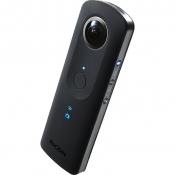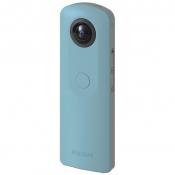Product Comparison: Ricoh Theta S vs Ricoh Theta SC
This site is a free online resource that strives to offer helpful content and comparison features to its visitors. Please be advised that the operator of this site accepts advertising compensation from certain companies that appear on the site, and such compensation impacts the location and order in which the companies (and/or their products) are presented, and in some cases may also impact the scoring that is assigned to them. The scoring that appears on this site is determined by the site operator in its sole discretion, and should NOT be relied upon for accuracy purposes. In fact, Company/product listings on this page DO NOT imply endorsement by the site operator. Except as expressly set forth in our Terms of Use, all representations and warranties regarding the information presented on this page are disclaimed. The information which appears on this site is subject to change at any time. More info






- Dual lenses. Most of the competition uses a single lens, meaning you necessarily end up with a blind spot. The dual fish-eye lenses have fields of view that overlap just beyond the camera body, meaning very little falls outside its gaze.
- Amazing Image Resolution and Dynamic Range.
- The resolution is substantially better in this model from the M-15 (which I also have). This tells me that Ricoh is capable of making even better Theta cameras in the future.
- Love it! Many complain about the resolution. It is not the greatest, but looks fantastic!
- Video in generally is terrible because of the low resolution. Pictures are ok.
- 1080p video is spread over the entire 360 degrees of the capture so it doesn't have high enough resolution for good or excellent quality. But, it looks fair when viewed on my computer using their app.
- It's not perfect, but at this price point I didn't expect it to be. The camera delivers a very nice resolution in stills and video.
- It's also great for landscapes or to capture a specific moment. The resolution is pretty good, although at times the photos seem dark.
- Image sensor can be reacher (by iphone 7 made pisc with more detail, but there is problem with adjustments stching)
- Resolution is much lower than I expected. I understand that, the small sensor need to cover a much larger area/FOV than a normal camera.
- Awesome but low resolution








- This is a cool device and it works well. The still image quality is good.
- The HDR capability for stills does a pretty decent job on indoor shots of rooms with brightly lit windows as well as saving the sky on bright sunny days!
- The low light image quality is MUCH better than the Ricoh Theta M15.
- Very small vith very nice picture. Try to shoot in HDR mode, that is the best quality.
- Video quality is horrendous if any type of movement is involved since there is no stabilization.
- For hdr photography the camera does not support any raw capture, so you have to accept whatever color correction Ricoh adds.
- Takes really cool photos that capture a moment in time.
- You will notice some chromatic aberration, and the images can look a bit grainy or pixelated when viewed on a large computer screen. But overall the images look really good when viewed on an iPhone or tablet.
- The Ricoh Theta SC is half the price of the S. Picture quality is the same as the S, a little more sensitive at night scene.
- Image quality is really bad I video. Bland and very grainy.
- The lens quality is terrible, chromatic aberrations are all over the place, and the signal range with the phone is just ridiculous, it's almost impossible not to be in the picture because if you hide too far, the camera won't shoot.
- The auto-stitching algorithm is fairly good at editing out the camera itself without cutting out anything else.
- Smartphone app control. If I can't have a display on the device, at least there is a sweet and feature-rich control app.
- Battery life seems very decent. I haven't completely run out of power yet, but a full charge apparently takes 4 hours or so.
- The compact form factor is amazing. It fits well even in jeans pockets.
- The included camera "case" is just a thin neoprene sleeve. Supposedly that's enough to protect the glass lenses, but I don't like how tightly the sleeve slides over the lenses.
- No native display, just a couple of potentially ambiguous LEDs.
- When using the smartphone app, there is a delay between shots because each picture must be processed and downloaded.
- iOS editing apps are pretty good, wish there was more support in third party apps.
- The app is easy to use. The camera can be operated from a cell phone from a distance. I made a video of a water fall from about 30 feet away.
- The weakest aspect of this product is actually its Android software. A little buggy, a little lacking in features. I had a couple instances where connection to the camera was sporadic but it may have been my phone getting overheated.
- The placement of the shutter button is remarkably bad, using it guarantees a nice big thumb in the frame that can't easily be masked or cropped out.
- Missing gps sensor (if shoot made without phone, there is no geolocation)


- I used a tripod that allows the camera to be fixed horizontally.
- This camera also mounts on normal tripods.
- I've also discovered lot of features after first uses, like Live video, that allows you to use it as a webcam, connected to you computer by USB cable, and you have also the ability to output as HDMI at HD quality.
- There's a standard micro USB connection and a not-so-standard mini-HDMI connection.
- Easy transfer of files, comes with a mini hdmi port.
- I did not have any connectivity issues with my I phone 7. Using the software on my I phone (Theta SC) and then uploading to Facebook.
- It has a threaded tripod mount on the base (which is also designed to allow one to stand it upright on flat surfaces, for hands-free shooting), and comes with a USB connector/charging lead.
- Charges the battery by attaching to the USB port of a computer, and delivers pictures through the same port.
- USB cable is very short.
Popular Comparisons
















